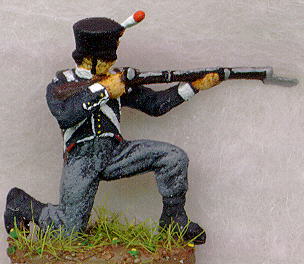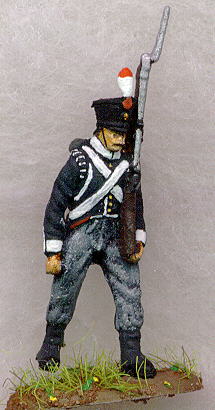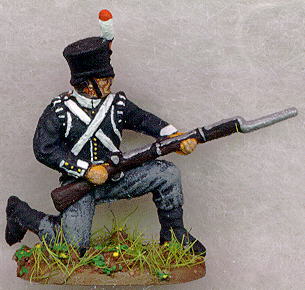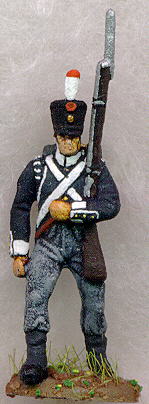
#8025 Napoleonic Dutch Infantry



Dated: August 23, 1999.
Close ups of painted Dutch figures. More figures to follow........









Above figures scanned at 300DPI, 100% and are approximately 5 1/2 times real size on a 15 inch screen.
Approx. actual size on a 15 inch screen.

All figures painted by Eric Williamson.
Notes from Mario Wens, a frequent contributor:
As far as is known the Dutch Army had no Flags in 1815! The army was in transition, the country recently liberated from twenty years of French occupation in 1813. The first priority was to get an Army that was armed, trained, clothed, and loyal to the new regime. Handing out Regimental Colours was no priority. The ´Hundred Days´came too early in this process. The Army was not ready with its transition yet. Von Pivka´s drawings in Osprey ´Dutch-Belgian troops of the Napoleonic wars´ shows the 1821 (1823? I´m not sure here) issue Flagpole and banners. At Waterloo the Dutch-Belgian Troops, as well as the Nassau troops under Dutch command (as far as I can remember from a letter I´ve seem to have misplaced) did march to war with bare flagpoles! A sorry sight.
It´s a good thing the Dutch-Belgian army of Waterloo finally gets some credit. The majority (*) of Wellington´s Army was not British, just as the vast majority of Marlborough's army hadn´t been a century earlier. Yet, with the exception of Blücher who simply had too many men with him to be overseen, the Battle has been depicted too often as a British victory.
The role of the Dutch-Belgian force, a significant part of the army and defending their own country at that, has normally been belittled and ridiculed. Too easily the fact is forgotten that these Dutch-Belgian units stopped Ney at Quatre-Bras (at great cost), thus blocking Napoleon´s grand scheme.
The retreat of Bylandt´s Brigade (tired from the Quatre Bras battle) at the start of the Battle of Waterloo has been depicted as a flight, where really it was a redeployment behind the ridge with the rest of the Army. It was conducted in good order and far too late: that brigade should never have been left on the exposed side of the ridge (Wellington saw them there but did nothing about it) in the first place.
That some Dutch-Belgian Cavalry units refused to charge is true: the 5th (Belgian) Light Dragoons had been mistaken by their allies for the French 6th Chasseurs á Cheval and were shelled by their own troops. The next charge they refused to move.
Finally, it was the Dutch Infantry (Chassé's Division) which held the line during the final assault of the Imperial Guard, until Brunswick troops could come to their aid. The Dutch Horse artilery finally broke the last French onslaught and thus secured victory.
Note on Jagers: The correct name for the regiments commonly referred to in the English literature as "Jägers" is in fact "JAGERS" without the German "Umlaut" on the letter A that is... Both the Dutch word 'Jager' as the German 'Jäger' mean 'Hunter' or 'Woodsman'. The plural of the Dutch word is 'Jagers', of the German 'Jäger' Neither language knows the form 'Jägers'. You might find 'Jäger' spelled as 'Jaeger' by the way, to make it all more complicating. Phonetically the Dutch 'Jagers' would be pronounced something like 'Jah-gers' for an English speaking person, whereas the German 'Jäger' is pronounced something like 'Jay-ger'.
All rights reserved. Any unauthorized or commerical use of content or images are violations of applicable laws and will be prosecuted to the fullest extent of the law. Opinions expressed on this page are only those of the writers and contributors and do not reflect the opinion of HäT Industrie, Inc. Any trademark usage or proprietary images on this page are only for the purposes of review or such, and is considered fair dealing and permissible under the Copyright, Design and Patents Act, 1988 (UK). Copyright 1999.